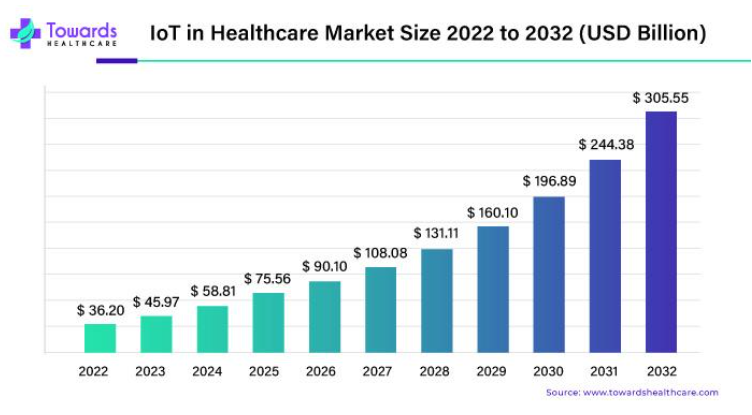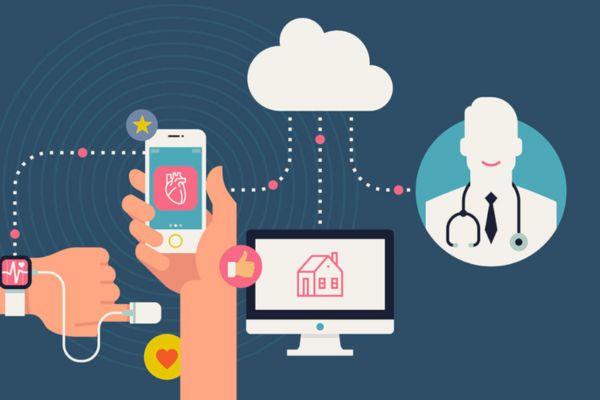According to recent market analyses by Towards Healthcare, the global IoT in healthcare market has already surpassed the impressive milestone of USD 36.20 billion by the year 2022. However, this is just the beginning of a transformative journey. Projections indicate that by the year 2032, the market is set to skyrocket to a staggering USD 305.55 billion, marking a remarkable compound annual growth rate (CAGR) of 23.4%. This unprecedented expansion underscores the significant role IoT technology plays in shaping the future of healthcare delivery worldwide.

Components Driving Growth
Among the various components fueling this growth, the hardware segment stands out prominently. In 2022, it dominated the market landscape with a commanding 58.25% market share. This dominance is a testament to the increasing adoption of IoT-enabled devices such as wearable sensors, smart medical devices, and remote monitoring tools. These hardware components form the backbone of IoT infrastructure, enabling seamless connectivity and real-time data transmission for healthcare providers and patients alike.
Applications at the Forefront
Within the realm of healthcare applications, telehealth emerged as a frontrunner in 2022, capturing a significant market share of 36.37%. The surge in telehealth services, driven by the need for remote patient monitoring and virtual consultations, has been instrumental in expanding access to healthcare services, especially in underserved areas. Additionally, telehealth solutions have proven invaluable during times of crisis, facilitating continuity of care amid global pandemics and natural disasters.
Benefits of Telehealth: Revolutionizing Healthcare Delivery
In recent years, telehealth has emerged as a transformative force in the realm of healthcare. With its innovative approach to delivering medical services remotely, telehealth has revolutionized the way patients access and receive care. In the wake of the COVID-19 pandemic, the importance of telehealth has been further underscored, as it offers a safe and convenient alternative to traditional in-person visits. In this comprehensive guide, we explore the myriad benefits of telehealth and why it represents the future of healthcare delivery.
1. Reduced Exposure to COVID-19
The foremost advantage of telehealth is its ability to limit physical contact, thereby lowering everyone’s exposure to COVID-19. By facilitating remote consultations and virtual visits, telehealth eliminates the need for patients to visit crowded waiting rooms or healthcare facilities, where the risk of virus transmission is heightened. This not only protects patients but also safeguards healthcare professionals, reducing the overall burden on the healthcare system.
2. Convenience and Accessibility
One of the primary appeals of telehealth is its unparalleled convenience and accessibility. With virtual visits, patients can receive healthcare services wherever they are, whether it’s in the comfort of their own homes, at work, or even while on the go in their cars. This eliminates the need for time-consuming travel and allows individuals to seek medical attention without disrupting their daily routines or commitments.
3. Time and Cost Savings
Telehealth offers significant time and cost savings for both patients and healthcare providers alike. By eliminating the need for in-person visits, telehealth reduces travel time and expenses associated with transportation. Additionally, virtual consultations can be conducted more efficiently, reducing wait times for appointments and allowing patients to receive timely care without the need for prolonged waiting periods.
4. Expanded Access to Specialists
One of the most impactful benefits of telehealth is its ability to expand access to specialized medical care, particularly for individuals residing in remote or underserved areas. With telehealth technology, patients can connect with specialists located far away from their hometowns, overcoming geographical barriers and ensuring they receive the highest quality of care regardless of their location. This democratization of healthcare ensures that all patients have access to the expertise they need to manage their health effectively.
5. Enhanced Continuity of Care
Telehealth facilitates seamless continuity of care by enabling healthcare providers to monitor patients remotely and coordinate their treatment plans more effectively. Through virtual follow-up appointments and remote monitoring tools, patients can stay connected with their healthcare team and receive ongoing support and guidance in managing their health conditions. This continuity of care not only improves patient outcomes but also enhances the overall patient experience by fostering a deeper sense of engagement and partnership in healthcare decision-making.
6. Improved Health Outcomes
Studies have shown that telehealth can lead to improved health outcomes for patients across a wide range of medical conditions. By providing timely access to care, facilitating proactive management of chronic diseases, and promoting patient engagement and adherence to treatment plans, telehealth plays a crucial role in preventing complications, reducing hospital readmissions, and ultimately improving the overall quality of life for patients. With its ability to deliver personalized, patient-centered care, telehealth is poised to drive positive health outcomes for individuals and communities alike.















